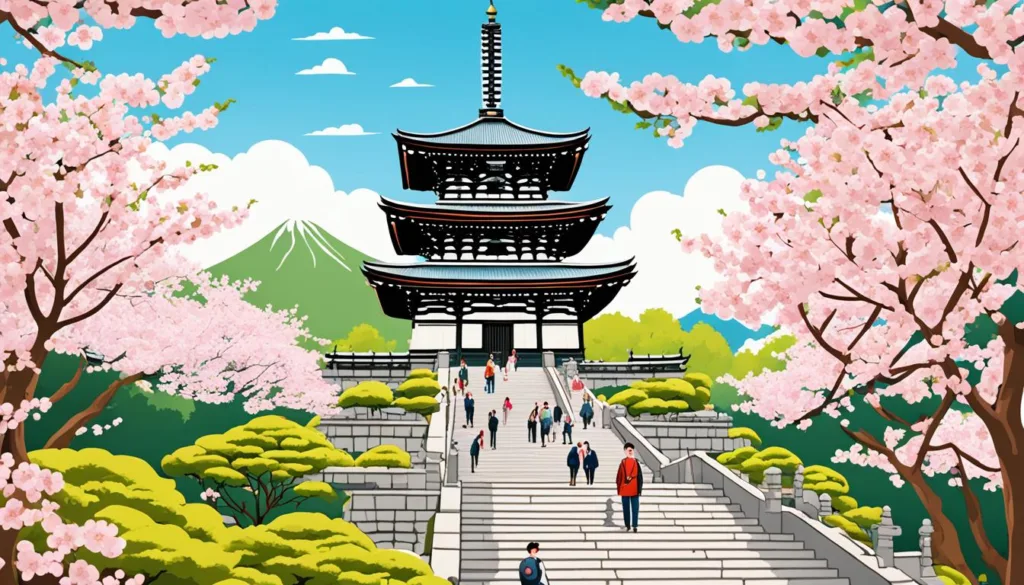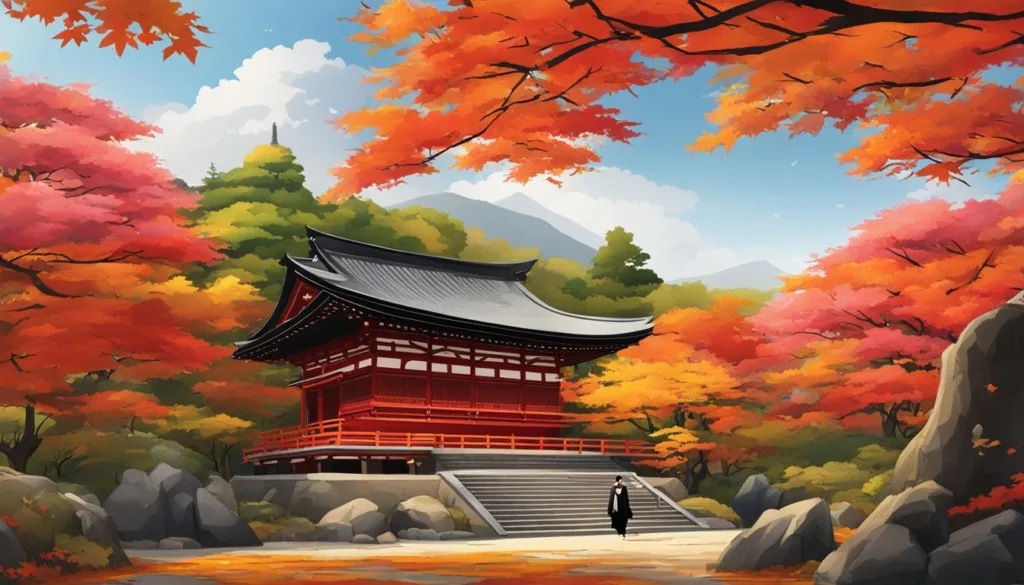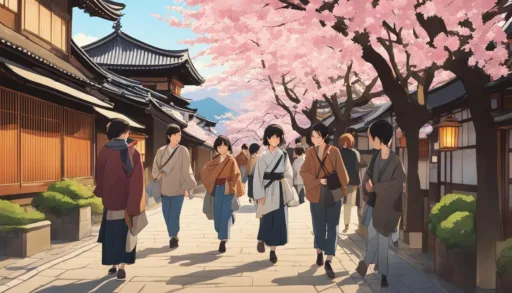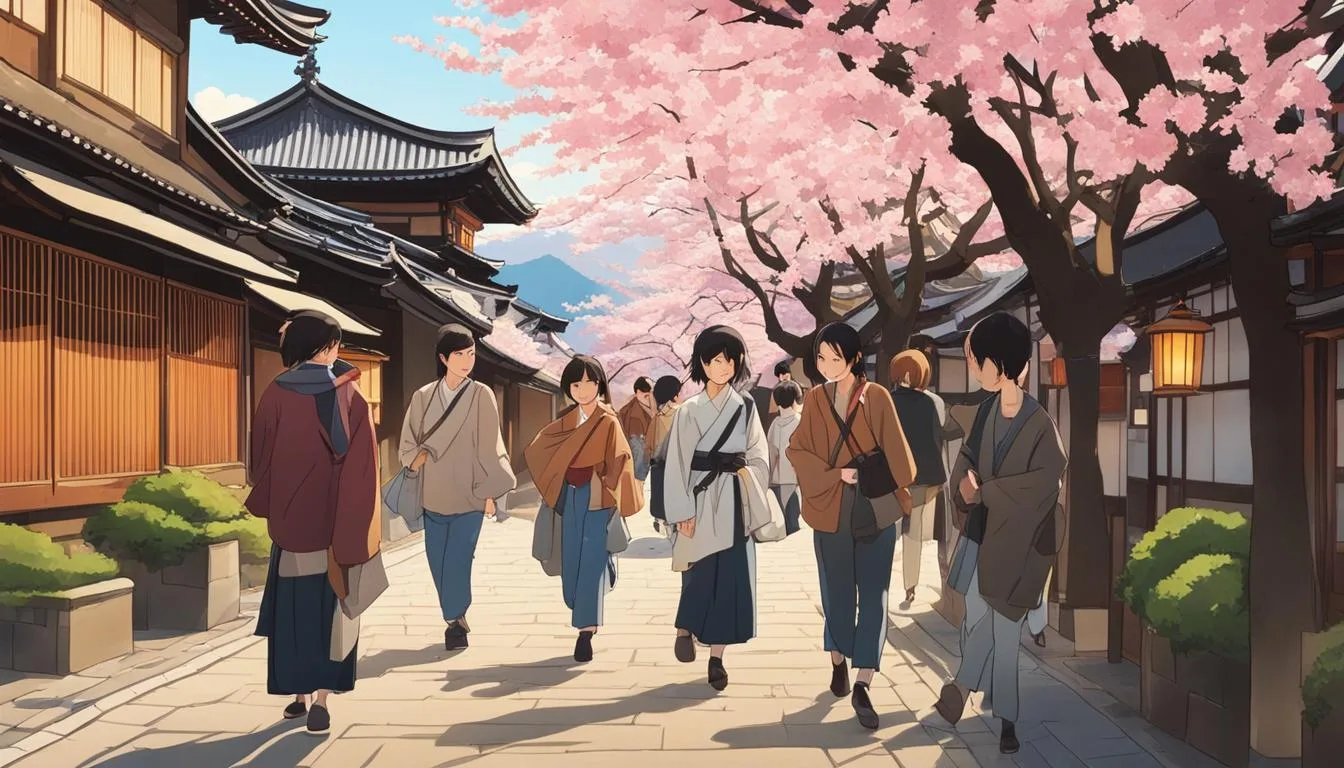Are you ready to step into a world where ancient traditions come to life and history whispers through the streets? Welcome to Kyoto, Japan’s heart of culture, where the past and present harmoniously coexist in a city like no other. Prepare yourself for a captivating journey through time as you explore the rich heritage and timeless beauty of Kyoto.
With over 1,600 temples, Kyoto offers an unparalleled opportunity to immerse yourself in Japan’s vibrant cultural tapestry. From the awe-inspiring Golden Pavilion to serene moss gardens and bustling high-tech districts, Kyoto’s allure extends far beyond its historical sites. With breathtaking landscapes and vibrant festivals, Kyoto is a city that will leave you forever enchanted.
So, why wait? Start planning your visit to Kyoto and embark on an unforgettable adventure. Discover the hidden gems, witness the intricate artistry of Japanese gardens, and immerse yourself in the spiritual ambiance of Kyoto’s temples. Get ready to experience the essence of Japan in its purest form.
Key Takeaways:
- Explore over 1,600 temples in Kyoto and immerse yourself in Japan’s rich cultural heritage.
- Experience the perfect blend of ancient traditions and contemporary cityscape in Kyoto.
- Discover the beauty of Kyoto’s hidden gems and lesser-known sanctuaries.
- Plan your visit to Kyoto during cherry blossom season or autumn for an enchanting experience.
- Follow temple etiquette and group temples in proximity to optimize your itinerary.
The Allure of Kyoto: More Than a City
Kyoto’s allure lies in its perfect blend of the old and the new. Wander through the city’s streets and discover a harmonious fusion of heritage buildings and contemporary structures. From centuries-old shops selling traditional crafts to bustling high-tech districts, Kyoto offers a unique cityscape that will fascinate visitors. Don’t miss the breathtaking landscapes, including cherry blossoms in spring and vibrant red maples in autumn, that add to the city’s irresistible charm.
Explore Kyoto’s hidden gems and immerse yourself in the captivating atmosphere of this culturally rich city. Whether you’re an art enthusiast, history buff, nature lover, or simply someone seeking a unique travel experience, Kyoto has something to offer for everyone. Let’s take a closer look at some of the most intriguing tourist attractions that make Kyoto an unforgettable destination.
1. Historic Temples and Shrines
No visit to Kyoto is complete without exploring its historic temples and shrines. These sacred sites not only showcase the city’s architectural grandeur but also offer a glimpse into Japan’s spiritual traditions. From the iconic Kinkaku-ji, also known as the Golden Pavilion, to the enchanting Fushimi Inari Taisha, with its thousands of vibrant red torii gates, each temple and shrine has its own unique charm and beauty. Lose yourself in the mystical atmosphere as you venture through these sacred spaces.
2. Arashiyama Bamboo Grove
Find tranquility amidst the towering bamboo stalks of the Arashiyama Bamboo Grove. This stunning natural wonder is a must-visit destination for nature lovers and photography enthusiasts. As you walk through the bamboo pathway, feel the gentle rustle of the leaves and immerse yourself in the serene ambiance of this picturesque spot. Don’t forget to capture the beauty of the grove in a photo that will forever remind you of the tranquility of Kyoto.
3. Gion District
Step into the traditional world of Kyoto by visiting the historic Gion District. This enchanting neighborhood is famous for its traditional wooden machiya houses and being the birthplace of the geisha culture. Stroll along the cobblestone streets and explore the teahouses, shops, and theaters that have remained unchanged for centuries. If you’re lucky, you might catch a glimpse of a geisha in her elegant kimono as she glides through the streets.
Immerse yourself in the allure of Kyoto and discover the hidden treasures that await. From ancient temples and serene gardens to vibrant festivals and traditional arts, Kyoto offers a cultural journey like no other. Plan your visit to explore the wonders of this captivating city and create memories that will last a lifetime.
Unearthing the Beauty of Kyoto’s Temples, Japan
Kyoto’s temples are a testament to the city’s enduring beauty and culture. With their architectural grandeur and spiritual significance, these sacred spaces offer a fascinating exploration of Japan’s history and artistry.
When visiting Kyoto, a visit to the iconic temples is a must. Start your journey at Kinkaku-ji, also known as the Golden Pavilion. Its stunning gold leaf exterior reflects beautifully in the surrounding pond, creating a mesmerizing sight. Take a stroll through the meticulously landscaped gardens and immerse yourself in the serene atmosphere.

Another must-visit temple is Ryoan-ji, famous for its rock garden. This unique and contemplative Zen garden consists of 15 carefully arranged rocks set amidst a bed of raked white gravel. Take a moment to sit back and appreciate the simplicity and tranquility of this minimalist masterpiece.
While exploring Kyoto’s temples, don’t miss the opportunity to discover the hidden gems of the city. Daigo-ji, nestled in the Higashiyama Mountains, offers a peaceful retreat away from the bustling city. Its vibrant autumn foliage and beautiful cherry blossoms make it a picturesque destination throughout the year.
“Kyoto’s temples are a reflection of Japan’s rich cultural heritage and provide a glimpse into the country’s spiritual traditions.” – Traveler’s Guide to Kyoto
A Kyoto Temple Itinerary:
To make the most of your temple exploration in Kyoto, consider the following itinerary:
- Start your day at Kinkaku-ji, the iconic Golden Pavilion, and marvel at its gilded beauty.
- Head to Ryoan-ji and spend time in contemplation at its mesmerizing rock garden.
- Visit Daigo-ji to experience a tranquil escape and immerse yourself in nature’s beauty.
- Explore Jisso-in, a lesser-known sanctuary known for its stunning tsukubai (stone washbasin).
By following this itinerary, you’ll get a taste of Kyoto’s famous temples and uncover the hidden gems that make this city a true cultural treasure.
A Journey Off the Beaten Path
While the renowned temples in Kyoto attract attention, there is something special about discovering the city’s lesser-known sanctuaries. These hidden gems offer a unique charm and tranquility that are often missed by tourists. If you’re looking for a more intimate experience, venture off the beaten path and explore the quiet beauty of temples like Enko-ji and Sanzen-in.
Enko-ji, nestled in a residential area, is a serene temple known for its stunning autumn foliage. Take a leisurely stroll through the temple grounds and be captivated by the vibrant hues of red and gold. The peaceful atmosphere and captivating natural scenery create a sense of calm and serenity.
Sanzen-in, located in the Ohara district, is another hidden gem worth visiting. This temple offers a breathtaking display of nature and tranquility. As you explore the temple’s moss garden and stroll along the stone pathways, you’ll feel a deep connection with the surrounding nature and find a moment of peace amidst the bustling city.
These off-the-beaten-path temples provide a unique and enriching experience for visitors. Whether you’re seeking solitude, a closer connection with nature, or simply a break from the crowds, these hidden gems in Kyoto are sure to leave a lasting impression.
“In the midst of Kyoto’s bustling cityscape, the hidden temples offer a serene escape where visitors can truly connect with the essence of Japanese culture and spirituality.” – Exploring Kyoto: Treading the Path Less Traveled
Insider Tip:
Include Enko-ji and Sanzen-in in your Kyoto itinerary for a unique and tranquil experience. Don’t forget to bring your camera to capture the beauty of these hidden gems!
Unearthing Hidden Treasures – Off-the-Beaten-Path Temple Guide:
- Enko-ji: A serene temple renowned for its autumn foliage.
- Sanzen-in: A hidden gem in the Ohara district, offering tranquility amidst nature.
When to Visit and What to Wear
Timing your visit to Kyoto can greatly enhance your temple experience. The city boasts unique seasonal attractions that showcase the beauty of nature and add to the overall charm of your Kyoto itinerary.
Spring Blossoms and Autumn Hues
Spring is a favored time to visit Kyoto when cherry blossoms paint the city in delicate shades of pink. Witnessing these ephemeral blooms at iconic locations such as Maruyama Park and the Philosopher’s Path is an enchanting experience you won’t want to miss. Meanwhile, autumn brings vibrant colors as the leaves turn gold and crimson. Explore Arashiyama’s bamboo forest or stroll through Tofuku-ji Temple’s magnificent maple grove to immerse yourself in the breathtaking countryside.
Quiet Times for Tranquility
If you seek a more intimate and peaceful atmosphere, early summer and late winter are ideal. These quieter periods offer a chance to savor the tranquility of Kyoto’s temples without the bustling crowds. Take a leisurely walk along the Philosopher’s Path, enchanting at the cherry blossom trees in the warm spring breeze, or explore the quiet corners of Kiyomizu-dera Temple during a serene winter snowfall.
Appropriate Attire and Footwear
Visiting temples in Kyoto often requires dressing in modest attire out of respect for the sacred sites. Avoid revealing clothing and opt for garments that cover your shoulders and knees. Comfortable walking shoes are essential for exploring the expansive temple grounds and navigating the city’s charming streets. Be prepared to remove your shoes when entering certain temple buildings.

Timing your visit to Kyoto and dressing appropriately will enable you to fully appreciate the enchanting beauty and cultural significance of the city’s temples. Whether you’re admiring cherry blossoms in spring or marveling at the vibrant autumn foliage, Kyoto offers a mesmerizing experience that will leave a lasting impression.
Temple Etiquette and Suggested Itineraries
When traveling to Kyoto and embarking on a sightseeing adventure through its enchanting temples, it is crucial to observe proper temple etiquette to show respect. By following specific guidelines and maintaining a quiet and mindful presence, you can fully appreciate the cultural significance of these sacred spaces.
Here are a few essential tips to keep in mind:
- Remove your shoes before entering temple buildings and be mindful of where you step, especially in areas with tatami flooring.
- Refrain from touching religious artifacts, statues, or other items within the temple premises.
- Do not take photographs or videos in designated areas where it is prohibited. Pay attention to signs or instructions indicating photography restrictions.
- Keep noise to a minimum, allowing other visitors to enjoy the serene atmosphere of the temples.
- Dress modestly and respectfully, covering shoulders and knees. It is advisable to bring a shawl or scarf to cover up if needed.
“The serenity of the temples is a testament to Japan’s deep-rooted traditions and spirituality. By practicing temple etiquette, visitors can fully immerse themselves in the incredible cultural experience Kyoto offers.”
Planning your temple visits with a well-thought-out itinerary can maximize your time and allow for a more immersive experience. To make the most of your trip, consider grouping temples that are in close proximity to each other. Here are a couple of suggested itineraries:
Suggested Itinerary 1:
| Temple | Duration |
|---|---|
| Kinkaku-ji | 1 hour |
| Ryoan-ji | 30 minutes |
| Ninna-ji | 1 hour |
Suggested Itinerary 2:
| Temple | Duration |
|---|---|
| Ginkaku-ji | 1 hour |
| Nanzen-ji | 1 hour |
| Kiyomizu-dera | 2 hours |
By organizing your temple visits around suggested itineraries, you can make the most of your time in Kyoto and witness the diverse architectural styles, serene gardens, and cultural heritage of these remarkable attractions.
Embark on a journey through Kyoto’s temples, where tranquility and awe-inspiring beauty intertwine. The rich cultural tapestry and spiritual significance will leave an indelible mark on your travel experience. Remember to respect temple etiquette, plan your itineraries wisely, and prepare to immerse yourself in the captivating world of Kyoto’s temples.
Historic Temples and Shrines: A Journey through Time
Kyoto’s spiritual landscape is home to over 1,600 temples and shrines, each with its unique charm and compelling history. These iconic destinations offer a glimpse into Japan’s rich cultural heritage and architectural marvels. Let’s explore some of the must-visit temple and shrine experiences in Kyoto.
Kinkaku-ji: The Golden Pavilion
One of Kyoto’s most famous landmarks, Kinkaku-ji, also known as the Golden Pavilion, is a mesmerizing sight to behold. The temple’s golden exterior reflects beautifully in the surrounding pond, creating a picturesque view. Its captivating architectural design and serene garden setting make it a must-see attraction in Kyoto.
Fushimi Inari Taisha: A Mystical Experience
Immerse yourself in the mystical atmosphere of Fushimi Inari Taisha, a shrine renowned for its thousands of vibrant torii gates. As you wander through the winding paths of Mount Inari, you’ll discover breathtaking views and a sense of tranquility. This spiritual journey is not to be missed during your visit to Kyoto.
Kiyomizu-dera: Panoramic Views of Kyoto
Experience panoramic views of Kyoto from the stunning Kiyomizu-dera, a temple perched on wooden stilts. Admire the intricate craftsmanship of its wooden architecture and explore the temple’s serene surroundings. Visit during cherry blossom season for a truly enchanting experience.
These are just a few examples of the enchanting temples and shrines that await you in Kyoto. Each has its own unique story and significance, offering a glimpse into Japan’s rich cultural tapestry. Take your time to explore these historic sites and be captivated by their timeless beauty.
Exploring Kyoto’s Traditional Japanese Gardens
Kyoto’s traditional Japanese gardens provide a serene haven for those seeking respite and connection with nature. These meticulously designed oases showcase the harmonious blend of beauty and tranquility that is characteristic of Japanese garden design. Embark on a journey through the city’s captivating gardens and discover the timeless allure they hold.
Ryoan-ji’s Rock Garden: Embracing Minimalism
Ryoan-ji’s rock garden is a testament to the power of simplicity. Composed of 15 carefully arranged rocks surrounded by meticulously raked gravel, it exudes an air of calm and tranquility. The minimalist design allows visitors to contemplate and find their own meaning in the arrangement, making it a meditative experience.
Ginkaku-ji’s Moss and Sand Gardens: Finding serenity in nature
Ginkaku-ji, also known as the Silver Pavilion, is famous for its stunning moss and sand gardens. The moss garden, featuring various shades of green, creates a soft and serene atmosphere. On the other hand, the sand garden, designed to represent a seascape, invites visitors to engage in the art of Zen meditation by raking patterns in the sand.
Tenryu-ji’s Breathtaking Landscape: A harmonious blend of nature and architecture
Tenryu-ji, a UNESCO World Heritage site, boasts a landscape that seamlessly integrates temples, gardens, and stunning natural scenery. The garden’s focal point is Sogen Pond, which reflects the surrounding mountains and trees, creating a breathtaking mirror-like view. Stroll along the paths, cross the arched bridge, and immerse yourself in the tranquility of this picturesque setting.
| Garden | Main Features |
|---|---|
| Ryoan-ji | Minimalist rock garden with meticulously raked gravel |
| Ginkaku-ji | Moss garden, sand garden for Zen meditation |
| Tenryu-ji | Breathtaking landscape with Sogen Pond as the centerpiece |
Each of Kyoto’s traditional Japanese gardens showcases a unique aspect of Japanese design and offers an opportunity for reflection and appreciation of nature’s harmony. Whether it’s the simplicity of Ryoan-ji, the serenity of Ginkaku-ji, or the breathtaking landscape of Tenryu-ji, these gardens provide a respite from the bustling city and a chance to connect with the essence of Kyoto’s cultural heritage.
The Intricate Artistry and Diverse Beauty of Japanese Garden Styles
Kyoto’s gardens are a testament to the intricate artistry and diverse beauty of Japanese garden styles. Each garden reflects a distinct aspect of Japanese culture and philosophy, offering visitors a truly immersive experience. As you explore these exquisite landscapes, you’ll discover the rich history and deep symbolism behind each garden style.
Karesansui – Dry Landscape Gardens
Karesansui, also known as dry landscape gardens, exemplify the Zen tradition and embody the principles of simplicity and harmony. Ryoan-ji, one of Kyoto’s most famous temples, features a mesmerizing rock garden where carefully raked gravel symbolizes water and rocks represent islands. This minimalist design invites contemplation and meditation, allowing visitors to find serenity amidst the seemingly abstract arrangement.
Tsukiyama – Hill Gardens
Tsukiyama, or hill gardens, can be found in temples such as Saisho-in. These gardens are designed to mimic natural landscapes, with gentle slopes, ponds, and meandering paths. Delicate bridges and strategically placed stones create a harmonious composition, evoking a sense of tranquility and balance. Strolling through a Tsukiyama garden is like embarking on a journey through picturesque mountains and valleys.
Chaniwa – Tea Gardens
“In the stillness of the tea garden, one can find solace and connect with nature’s beauty.”
Chaniwa, or tea gardens, are an integral part of the traditional Japanese tea ceremony. These gardens, seen at places like Kodai-ji, are meticulously designed to create a peaceful atmosphere for the tea ritual. Gravel paths, carefully trimmed hedges, and stone lanterns guide visitors to the teahouse, where they can experience the harmonious blend of aesthetics, ritual, and tranquility.
Immerse yourself in the principles of simplicity, harmony, and balance as you explore Kyoto’s gardens. From the meditative beauty of Karesansui gardens to the natural serenity of Tsukiyama gardens, and the elegance of Chaniwa gardens, each style offers a unique perspective on the artistry and beauty of Japanese gardens.
Conclusion
Discover the captivating allure of Kyoto, the heart of Japan’s cultural heritage. This enchanting city offers a journey through time, allowing you to immerse yourself in the rich traditions and timeless beauty of Japan. With its ancient temples, awe-inspiring shrines, and stunning gardens, Kyoto is a treasure trove of cultural experiences.
When planning your visit, be sure to consult a Kyoto travel guide to make the most of your itinerary. Follow temple etiquette to show respect and create a harmonious atmosphere during your temple visits. Don’t miss the opportunity to explore the hidden gems of Kyoto, where you’ll find tranquility and unique charm away from the crowds.
Embark on a memorable journey to Kyoto and indulge in the city’s captivating beauty. Immerse yourself in the vibrant culture, witness the breathtaking landscapes, and savor the serenity of traditional Japanese gardens. Whether you’re a history enthusiast, a nature lover, or a seeker of cultural experiences, Kyoto awaits with open arms, ready to enchant you with its timeless allure.






